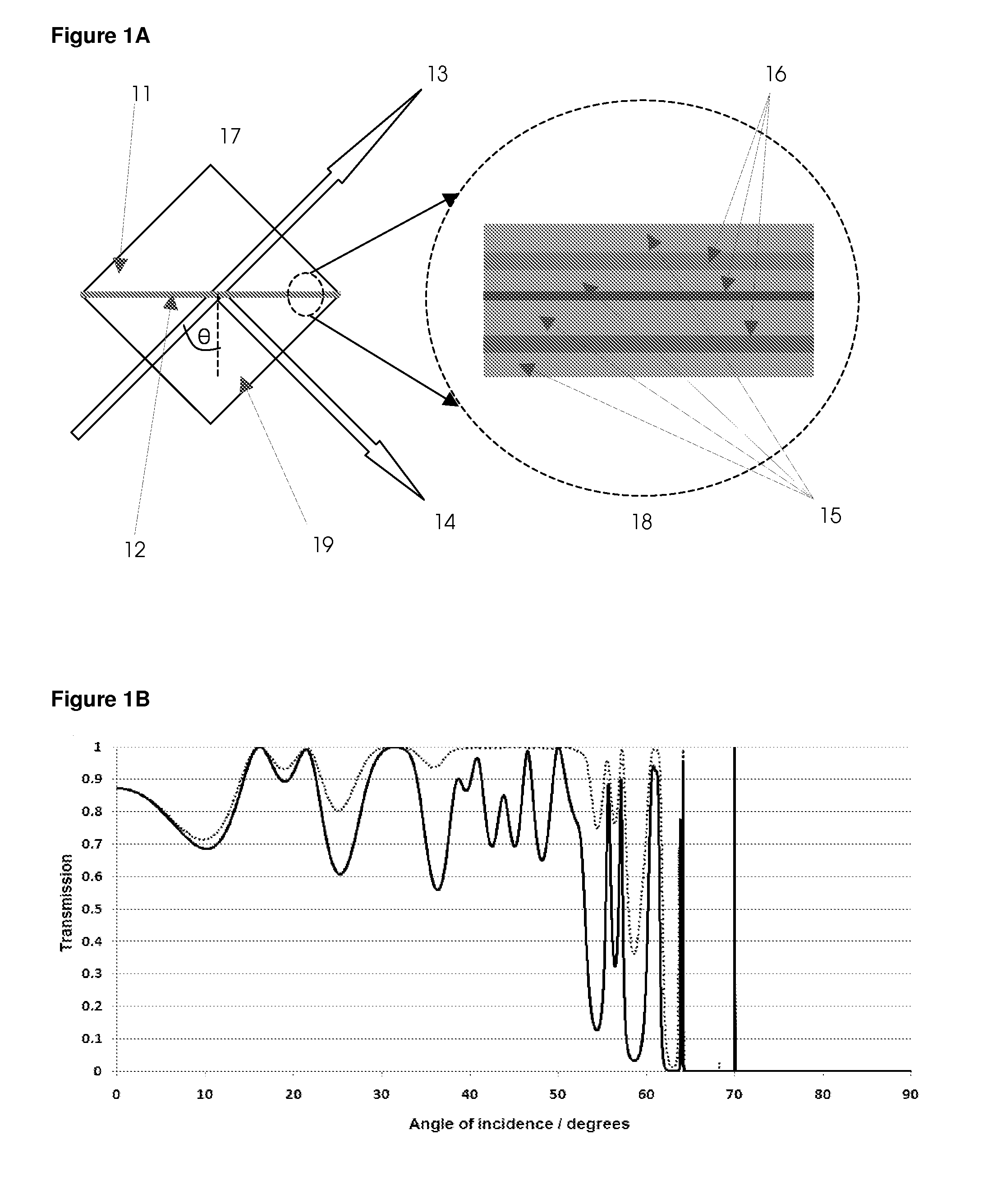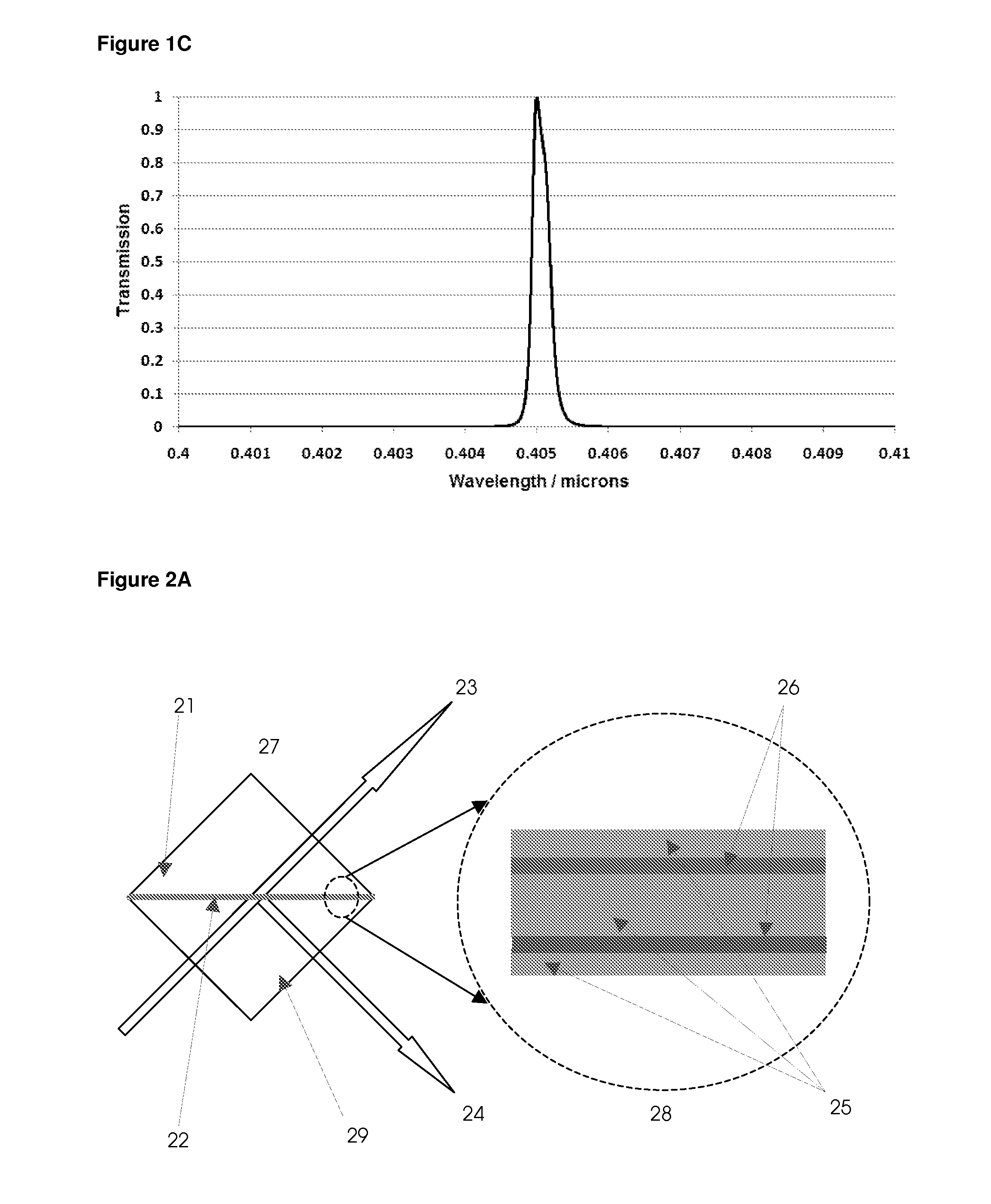Optical spectral filter, angular filter and polariser
a technology of optical spectral filter and polariser, applied in the direction of layered products, instruments, lamination, etc., can solve the problems of only narrow bandwidth, unwanted diffraction effects, and add to the size and complexity of the devi
- Summary
- Abstract
- Description
- Claims
- Application Information
AI Technical Summary
Benefits of technology
Problems solved by technology
Method used
Image
Examples
first embodiment
[0060]In the first embodiment, there is provided a filter for spectrally filtering, polarising and for some embodiments also angularly filtering input light. The relevant figures are FIG. 1A, FIG. 1B and FIG. 1C.
[0061]The structure comprises:
[0062]Input prism 19, assumed to be of an isotropic material, with refractive index 1.52
[0063]First layer, adjacent to the input prism, assumed to be of an isotropic material, with refractive index 1.38, and thickness 0.55 microns
[0064]Second layer, adjacent to the first layer, assumed to be of an isotropic material, with refractive index 1.85, and thickness 0.03335 microns
[0065]Third layer, adjacent to the second layer, assumed to be of an isotropic material, with refractive index 1.38, and thickness 1.1 microns
[0066]Fourth layer, adjacent to the first layer, assumed to be of an isotropic material, with refractive index 1.75, and thickness 0.44517 microns
[0067]Fifth layer, adjacent to the first layer, assumed to be of an isotropic material, wit...
second embodiment
[0075]In the second embodiment, there is provided a filter for spectrally filtering, polarising and angularly filtering input light. The relevant figures are FIG. 2A, FIG. 2B, FIG. 2C, and FIG. 2D.
[0076]The structure comprises:
[0077]Input prism 29, assumed to be of an isotropic material, with refractive index 1.52
[0078]First layer, adjacent to the input prism, assumed to be of an isotropic material, with refractive index 1.38, and thickness 0.5 microns
[0079]Second layer, adjacent to the first layer, assumed to be of an isotropic material, with refractive index 1.85, and thickness 0.03336 microns
[0080]Third layer, adjacent to the second layer, assumed to be of an isotropic material, with refractive index 1.38, and thickness 1 micron
[0081]Fourth layer, adjacent to the third layer, assumed to be of an isotropic material, with refractive index 1.65, and thickness 0.31062 microns
[0082]Fifth layer, adjacent to the fourth layer, assumed to be of an isotropic material, with refractive index...
third embodiment
[0093]In the third embodiment, there is provided a filter for spectrally filtering, polarising and angularly filtering input light. A demonstration filter corresponding to this embodiment has been fabricated using methods below and tested. Results will be presented below. The relevant figures are FIG. 3A, FIG. 3B and FIG. 3C.
[0094]The structure depicted here is:
[0095]Input prism 39, assumed to be of an isotropic material, with refractive index 1.52
[0096]First layer, adjacent to the input prism, assumed to be of an isotropic material, with refractive index 1.38, and thickness 0.5 microns
[0097]Second layer, adjacent to the first layer, assumed to be of an isotropic material, with refractive index 1.65, and thickness 0.0656 microns
[0098]Third layer, adjacent to the second layer, assumed to be of an isotropic material, with refractive index 1.38, and thickness 1 micron
[0099]Fourth layer, adjacent to the third layer, assumed to be of an isotropic material, with refractive index 1.65, and...
PUM
| Property | Measurement | Unit |
|---|---|---|
| Angle | aaaaa | aaaaa |
| Wavelength | aaaaa | aaaaa |
| Wavelength | aaaaa | aaaaa |
Abstract
Description
Claims
Application Information
 Login to View More
Login to View More - R&D
- Intellectual Property
- Life Sciences
- Materials
- Tech Scout
- Unparalleled Data Quality
- Higher Quality Content
- 60% Fewer Hallucinations
Browse by: Latest US Patents, China's latest patents, Technical Efficacy Thesaurus, Application Domain, Technology Topic, Popular Technical Reports.
© 2025 PatSnap. All rights reserved.Legal|Privacy policy|Modern Slavery Act Transparency Statement|Sitemap|About US| Contact US: help@patsnap.com



